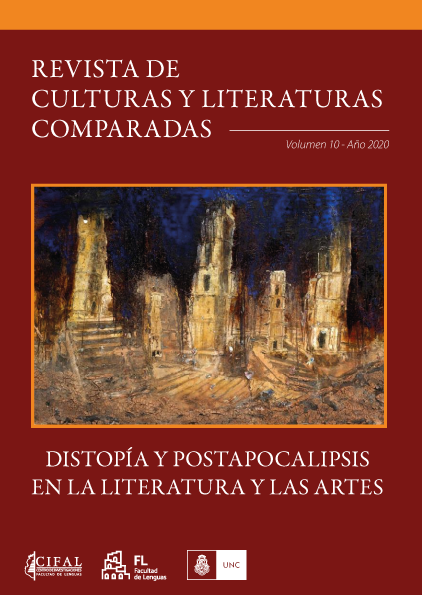Construing the Postapocalypse in Two Different Spaces and Artistic Languages: Margaret Atwood and Adrián Villar Rojas
Mots-clés :
Postapocalypse, dystopia, literature, the plastic artsRésumé
From a thematic approach to literature and the arts, the article aims at exploring and comparing how the Postapocalypse is constructed in the trilogy MaddAddam by Canadian writer Margaret Atwood (n. 1939) and the recent works of the young Argentinean sculptor Adrián Villar Rojas (n. 1980). The production of both artists is approached as belonging to a dystopian tradition, defined mainly from Frederic Jameson’s point of view. The main interest of Atwood’s trilogy is centered on the conditions of survivalof the human species on the planet after the “waterless flood”, a pandemic produced in a laboratory of bioengineering. Atwood believes in the possibility of survival, in a new beginning of culture on the planet on the basis of an unprecedented hybrid life born out of the mixing of human beings and beings born in laboratories, and a new approach to animal and natural life. As to Villar Rojas, though his first site-specifics are quite pessimistic as to the fate of the planet, in the title of one of his XXIst Century exhibitions -Today We Reboot the Planet, in the Serpentine Sackler Gallery, London (2013)- the faith in a Postapocalypse begins to emerge. The analysis will precisely focus on the techniques he uses in his celebrated site-specific art to attain this aim.
Téléchargements
Références
Atwood, Margaret. The Handmaid’s Tale. Toronto: McClelland and Stewart,1985.
---. Oryx and Crake. London: Virago Press, 2004.
---.The Year of the Flood. London: Bloomsbury, 2009.
---.MaddAddam. Toronto: McClelland & Stewart, 2013.
Braidotti, Rosi. Lo posthumano. Barcelona: Gedisa, 2015.
Bremme, Bettina. Mi familia muerta. Goethe-Institut.V.2009. Web. 30 Jul. 2014.
Elgue, Cristina. “El AntiguoTestamento en la ficción distópica de Margaret Atwood. Hacia nuevos contratos sociales”. El resto es silencio.
Coords. Miguel Ángel Montezanti y Gabriel Matelo. Buenos Aires: Ed. Biblos, 2012.
Evans, Brad & Zygmunt Bauman. “The Refugee Crisis Is Humanity’s Crisis”. The New York Times. 02 mayo 2016. Web.15 Jun. 2020.
Frye, Northrop. The Great Code. The Bible and Literature. Academic Press Canada: Toronto, 1982.
Fundación Princesa de Asturias. “Prince of Asturias Award 2008”. Web. 15 Jun. 2020.
Haas, Oliver. “Adrián Villar Rojas larger than life sculpures from another universe”. Yatzer Art. Web. 16 Mar. 2016. Web. 15 mayo 2016.
Haraway, Donna. Ciencia, Cyborgs y Mujeres. Madrid: Ediciones Cátedra, 1995.
Jameson, Frederic. “Utopía de la posmodernidad”. Confines. Año I, N. º1. Buenos Aires, 1995. 23-29.
Jones, Jonathan. “Why I made Curt Cobain out of clay”. The Guardian. 19 Sept. 2013. Web. 20 mayo 2015.
Martel, Yann. Beatrice & Virgil. New York: Knopf Canada, 2010.
Ricuperati, Gianluigi. “Adrián Villar Rojas interviewed by Gianluigi Ricuperati”. Milan Art Bulletin, 2016. Web. 15 mayo 2020.
Searle, Adrián. “Istanbul Biennial 2015: an overwhelming meditation on the tides of human misery”. The Guardian. 7 Nov. 2015. Web. 30 marzo 2016.
Terray, Emmanuel. “La vision du monde de Claude Lévi-Strauss”. Revue francaised’antropologie193, Hommage a Claude Lévi-Strauss (2010): 23-44. Web. 15 Jun. 2020.
Thill, Scott. “Margaret Atwood, Speculative Fiction’s Apocalyptic Optimist”. Wired (20 Oct. 2009). Web. 22 Feb. 2011.
Téléchargements
Publiée
Numéro
Rubrique
Licence

Ce travail est disponible sous licence Creative Commons Attribution - Pas d'Utilisation Commerciale - Pas de Modification 4.0 International.
Aquellos/as autores/as que tengan publicaciones con esta revista, aceptan los términos siguientes:
a) Los/as autores/as conservarán sus derechos de autor y garantizarán a la revista el derecho de primera publicación de su obra, el cual estará simultáneamente sujeto a la Licencia de reconocimiento de Creative Commons.
b) La cesión de derechos no exclusivos implica que la publicación de los artículos en la presente revista no quita la posibilidad o el derecho al autor/a de publicar su obra de manera posterior en otras revistas u órganos editoriales y la autorización por parte de los/as autores/as para que el trabajo sea depositado en los repositorios institucionales, tales como el Portal de Revistas de la Universidad Nacional de Córdoba.



